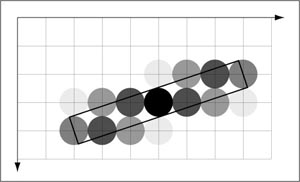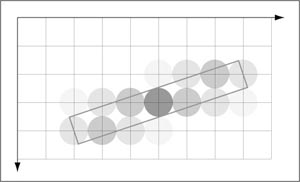1.1.3. Minimum Dimensions
The symbolization of graphical objects for screen maps has to be adapted to the peculiarities of screens. Line widths, minimum sizes for point symbols and minimum distances between graphical elements have to be larger than on paper maps in order to be optically well discernible.
Line width
| Line width (Brühlmeier 2000) |
The picture on the left shows how lines with different line
thicknesses are visualised on a screen. You might be surprised not to
see the expected difference of the width of two lines. For example with
the Adobe |
You might ask yourself how it is possible to visualise a line that is smaller that one pixel which is the smallest element of a screen. If so, have a look at the popup window below.
Click here for more information
Minimum distances
| Minimum distance between surfaces (Brühlmeier 2000) | Minimum distance between lines of different widths (Brühlmeier 2000) |
A series of test objects is used to identify the minimum distance
between two surfaces. In order to unequivocally differentiate the two
areas, they have to be separated by at least 1 pixel. A similar test can
be done with lines to find the minimum distance for linear elements. As
you can see in the right figure 1.5 pixel is that minimum distance. But
for very thin lines the distance is 2 pixels, since they are rendered in
grey. (Räber et al. 2003) |
Dimension of point signatures
| Minimum dimension of point signatures (Brühlmeier 2000) |
|
The distance the user keeps to the display device when studying a web map is approximately 80 cm, whereas a paper map is typically held at a distance of only 30 cm. In case of doubts, distances between map elements and minimum sizes of signatures should be chosen larger rather than smaller. (Räber et al. 2003)


